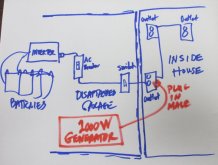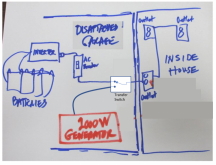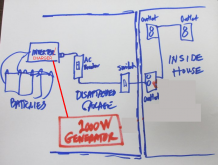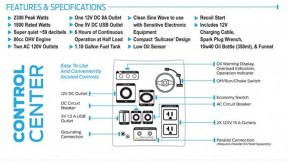wade0000
New Member
- Joined
- Oct 30, 2020
- Messages
- 66
Hello,
I am in the process of running a completely separate circuit from my unattached garage that has the solar system in it, into my house.
This separate circuit will only have 2 or 3 outlets inside the house and will be used only for emergency lighting, emergency fans, etc.
HOWEVER.... I was just thinking, that since the power from the batteries is relatively small, could I hook up my small gas generator (2000W) and as an option if the power is going to be out long or the panels are covered up by heavy snowstorm... that I instead run the 2000W gas generator INTO THIS DEDICATED CIRCUIT.
There is obviously a switch between the power connect so it would not back feed the breaker and inverter. I know I would need to be careful and not have both on at once.. .but wanted to hear what you fine people thought about the idea.. Any yes, I know that a male with male cord is not the ideal. Grounding would have to be double checked with regard to the generator for sure.
Here is a sketch...

I am in the process of running a completely separate circuit from my unattached garage that has the solar system in it, into my house.
This separate circuit will only have 2 or 3 outlets inside the house and will be used only for emergency lighting, emergency fans, etc.
HOWEVER.... I was just thinking, that since the power from the batteries is relatively small, could I hook up my small gas generator (2000W) and as an option if the power is going to be out long or the panels are covered up by heavy snowstorm... that I instead run the 2000W gas generator INTO THIS DEDICATED CIRCUIT.
There is obviously a switch between the power connect so it would not back feed the breaker and inverter. I know I would need to be careful and not have both on at once.. .but wanted to hear what you fine people thought about the idea.. Any yes, I know that a male with male cord is not the ideal. Grounding would have to be double checked with regard to the generator for sure.
Here is a sketch...







